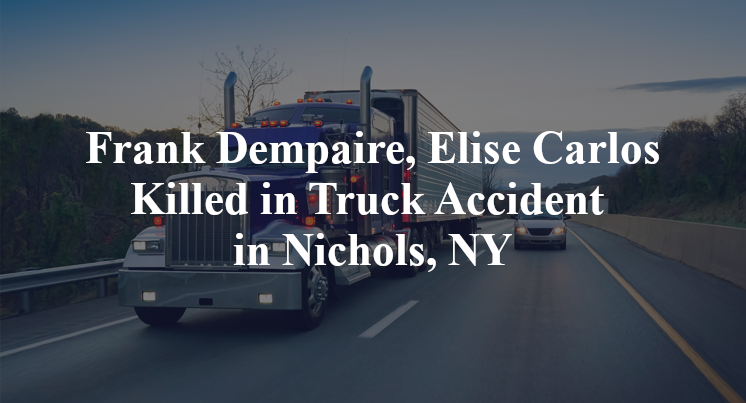Frank Dempaire, Elise Carlos Killed in Truck Accident in Nichols, NY
Update (September 11, 2025): Authorities have identified the people killed in this accident as Reading, PA resident Frank J. Dempaire, 45, and Newark, NJ resident Eliza Carlos, 45.
Nichols, NY — September 8, 2025, two people were killed in a truck accident at about 4:30 a.m. on eastbound Interstate 86/Southern Tier Expressway.
Authorities said an eastbound semi-truck crashed into the back of a passenger vehicle near exit 62.

Both people inside the car died in the crash, according to authorities. Their names have not been made public yet.
The truck driver was not hurt, authorities said.
Authorities have not released any additional information about the Tioga County crash at this time. The accident is still under investigation.
Commentary
When people hear about a deadly crash involving a semi-truck rear-ending a passenger vehicle, their first thought is often, “How does something like this even happen?” That’s the right question to ask, especially since this took place on a major expressway in the early morning hours. At the moment, we know that a tractor-trailer hit the back of a passenger vehicle on eastbound I-86, and both people in that car lost their lives. Beyond that, the details are scarce.
But even with the limited information available, a few critical issues come into focus, issues that will only be answered through a serious, evidence-based investigation.
First and foremost: Why did the truck hit the car from behind? Crashes like this raise the possibility of several contributing factors: driver distraction, fatigue, speed, mechanical failure or even poor visibility. But at this point, we don’t know whether the car was moving or stopped at the time of impact. That single detail changes the entire framework of the analysis.
If the passenger vehicle had stopped on the highway, investigators will need to ask why. Did it break down? Were its hazard lights on? Was there enough time for the truck driver to see and react?
If the vehicle was moving, then the question shifts to the truck: Was the driver following too closely? Was he fatigued or distracted? These aren’t idle questions. They’re answerable with the right evidence.
For example, most modern trucks are equipped with engine control modules, or ECMs, which act like a black box. Its data can show whether the truck was accelerating or braking before the crash. Cell phone records may tell us whether the driver was on a call or using a messaging app at the time. And in-cab cameras, common in many fleets today, can help confirm where the driver’s attention was focused in the moments leading up to impact.
Another key piece of the puzzle is the trucking company itself. What were their hiring and training practices? What kind of oversight did they have in place to make sure their driver was fit for the job? I’ve handled cases where a company hired a driver with multiple firings on his record and handed him the keys after a 20-minute “skills test.” In one instance, the company’s recklessness was so extreme that a jury held them more accountable than the driver himself.
The point is this: Determining fault in a crash like this isn’t just about pointing fingers. It’s about pulling every thread and seeing where it leads. Because until that’s done, we won’t know whether this was a fluke accident or the inevitable result of preventable mistakes.
Key Takeaways:
- It’s not clear whether the car was stopped or moving when the truck rear-ended it. Each scenario raises different legal questions.
- Investigators should review ECM data, cell phone records and in-cab video to understand what the truck driver was doing before the crash.
- The trucking company’s hiring, training and supervision practices may also play a role in determining liability.
- Accountability depends on getting the full picture; not just from crash scene evidence, but from what happened leading up to it.
- Serious investigations rely on hard evidence, not assumptions or surface-level details.

“These are essential reads for anyone dealing with the aftermath of a truck wreck”– Attorney Cory Carlson